Electric Capital 2023 Developer Report: The number of developers overall dropped by 24%
Original author:Electric Capital
Original compilation: Felix, PANews (this article has been abridged)
Main points
While monthly active developers fell overall by 24%, the most valuable segment of developers (those with 2+ years of experience and the most code contributions) continued to grow steadily.
Developers who have been in the crypto space for more than 2 years have experienced an annual growth rate of 52% over the past 5 years, reaching an all-time high.
Developers who have been working in cryptocurrency for more than 1 year increased by 16% year-on-year and accounted for 63% of all monthly active developers.
In comparison, newcomers who have been in the crypto market for less than 1 year fell by 52% year over year.
The overall developer loss can be attributed to a record number of new developers joining and exiting in 2022.
The encryption market is currently clearly multi-chain.
30% of developers support more than one chain, a tenfold increase from 3% in 2015.
Developers supporting more than 3 chains will grow to 17% of all developers in 2023, a record high.
Developer growth is not correlated across projects. Some projects gain developers, while others lose developers. Developers are voting with their feet for projects they believe will provide real utility.
The crypto market is global, and U.S. developer share continues to decline.
72% of developers are located outside of North America.
The U.S.’s developer share has dropped by 14% since 2018 and now accounts for only 26% of crypto developers.
South Asia, Latin America, Eastern Europe, West Africa and Southern Europe have collectively seen a 20% increase in developer share since 2018.
Developer overview
There are 22,411 active open source developers contributing to the crypto industry every month.

The number of monthly active developers fell by 24% in 2023.

But there is a steady increase in developers who have been working in the crypto field for more than 1 year. Breaking down developers by tenure shows a steady increase in both emerging developers (1-2 years) and established developers (2+ years).
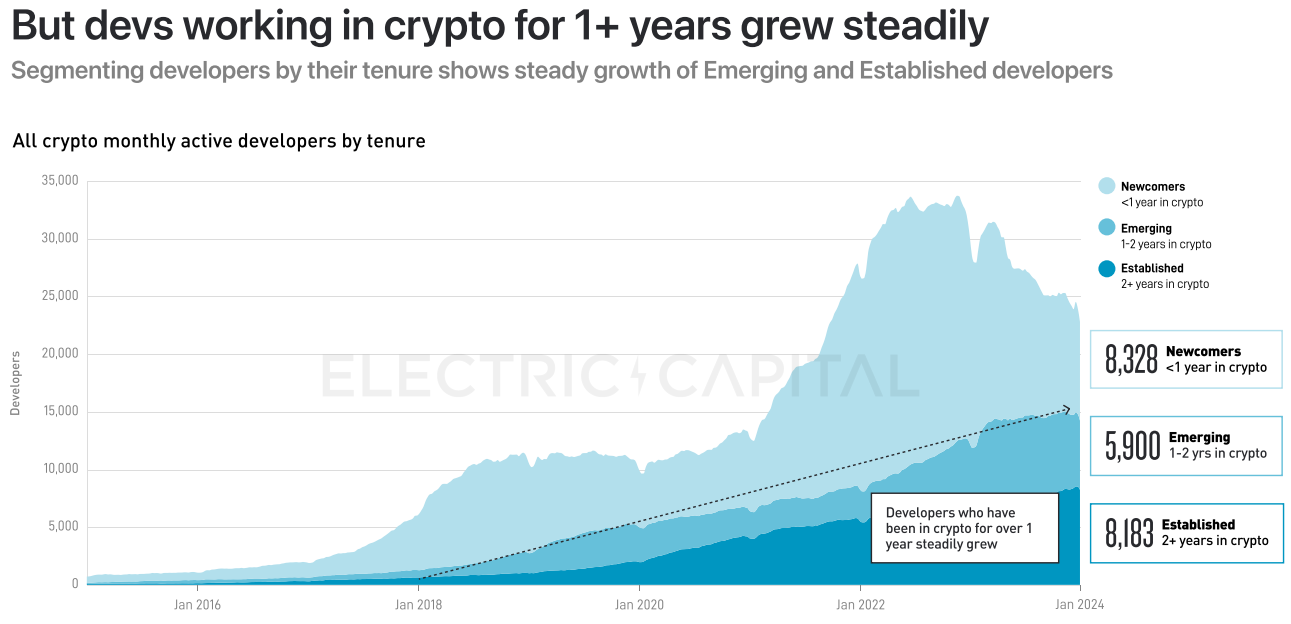
Experienced developers (1+ years) will grow 16% in 2023 (+1,925). This reflects an increase of 1,925 developers excluding newcomers.

Experienced developers write more code: 75% of code is created by developers who have been on the job for more than 1 year.

Developers who have been working in crypto for more than 1 year consistently contribute more than newcomers. Established and emerging developers average 3x more code commits than new developers (less than 1 year old).

Mature developers have grown 52% annually over the past 5 years and are at an all-time high.

The developers who are lost are those with the shortest tenure: 52% of new developers are lost.
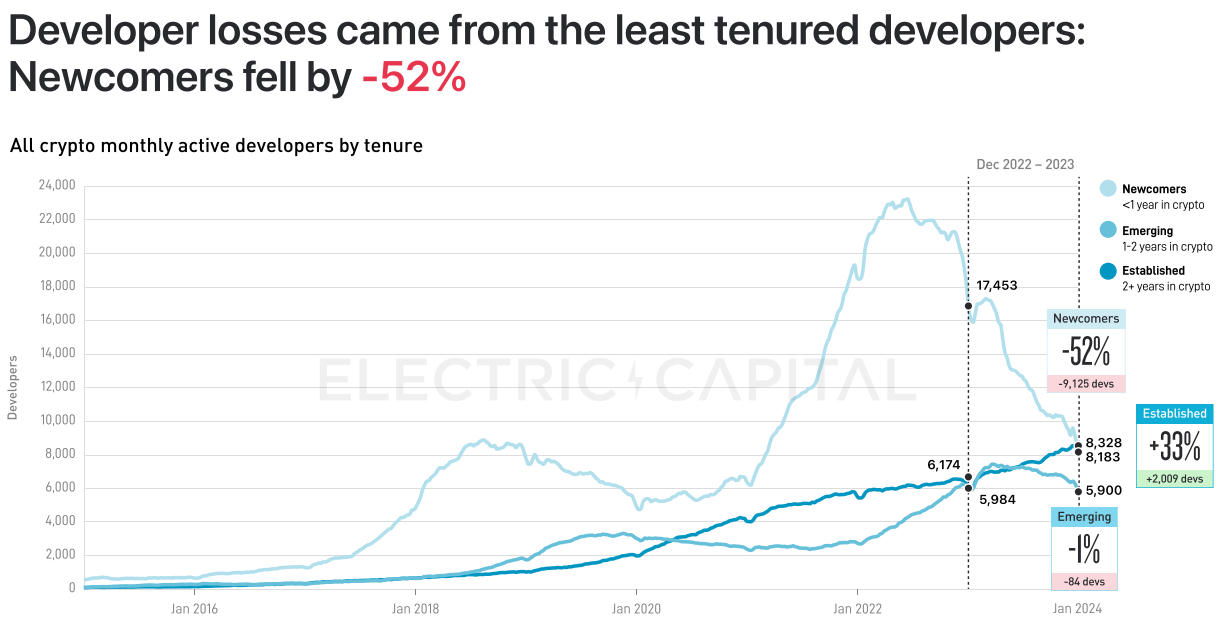
The change in the number of new developers is consistent with the market changes, with 90,330 developers joining the encryption field in 2022.

After crypto market capitalization hit an all-time high in 2022, more than 6,500 new people are joining the crypto space every month.

Entering the bear market in 2023, more than 3,000 developers are joining almost every month.

The number of developers deploying to multiple chains is increasing
Many developers now contribute to multiple blockchains. In 2023, 34% of developers develop for multiple chains, of which 8.2% support five or more chains.

The number of multi-chain developers has grown 10x since 2015. In January 2015, only 3% of monthly active developers supported multi-chain. In the years after 2018, multi-chain monthly active developers increased by 125%.

30% of developers have been working on 2 or more chains for 3 years.

The number of developers developing 3 chains or more is at an all-time high (accounting for 17% of the total developers).

In 2018, most multi-chain developers were working on the Bitcoin Lightning Network and Ethereum and Polkadot.

Today, developers are building multiple interconnected ecological clusters. Over time, more ecologies are sharing more developers.

Currently, Ethereum shares the most developers with Polygon, BNB, Arbitrum, and Optimism. Among them, Ethereum shares more than 6 full-time developers with 26 chains.

EVM compatible chains share developers with other EVM chains.

Multi-chain developers are segmented based on whether they work on: EVM-only chains, only non-EVM chains, or a mix of the two.

87% of multi-chain developers work on at least 1 EVM chain. Only 13% of multi-chain developers work on non-EVM chains.

BNB Chain shares 39% of multi-chain deployers with Ethereum, Polygon at 36%, and Avalanche at the lowest at 18%.
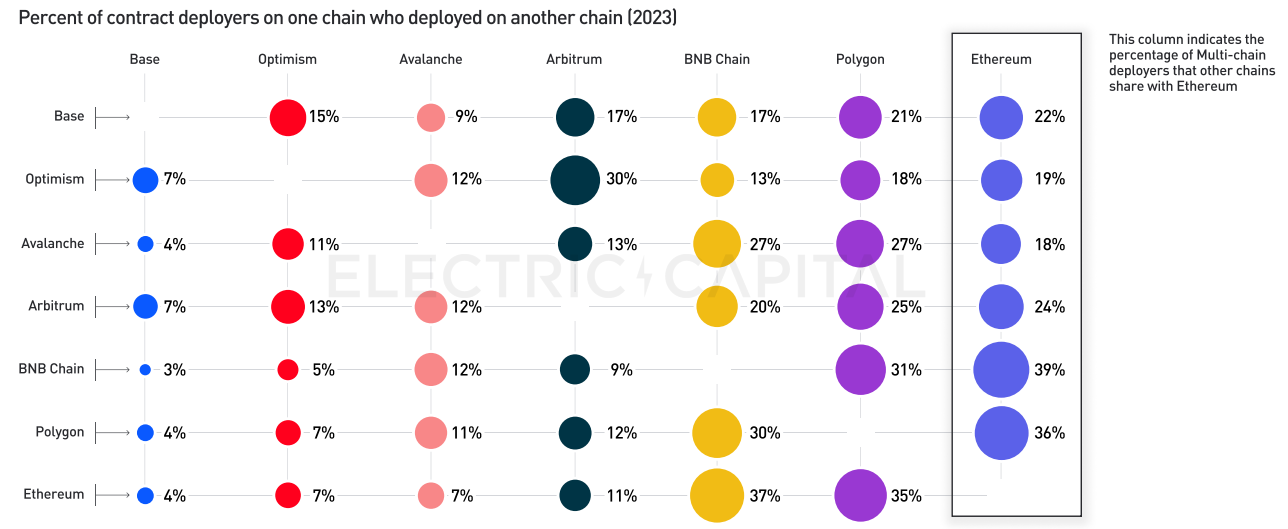
37% of Ethereum multi-chain developers also participate in the deployment of BNB Chain; 35% of Ethereum multi-chain developers participate in the deployment of Polygon.
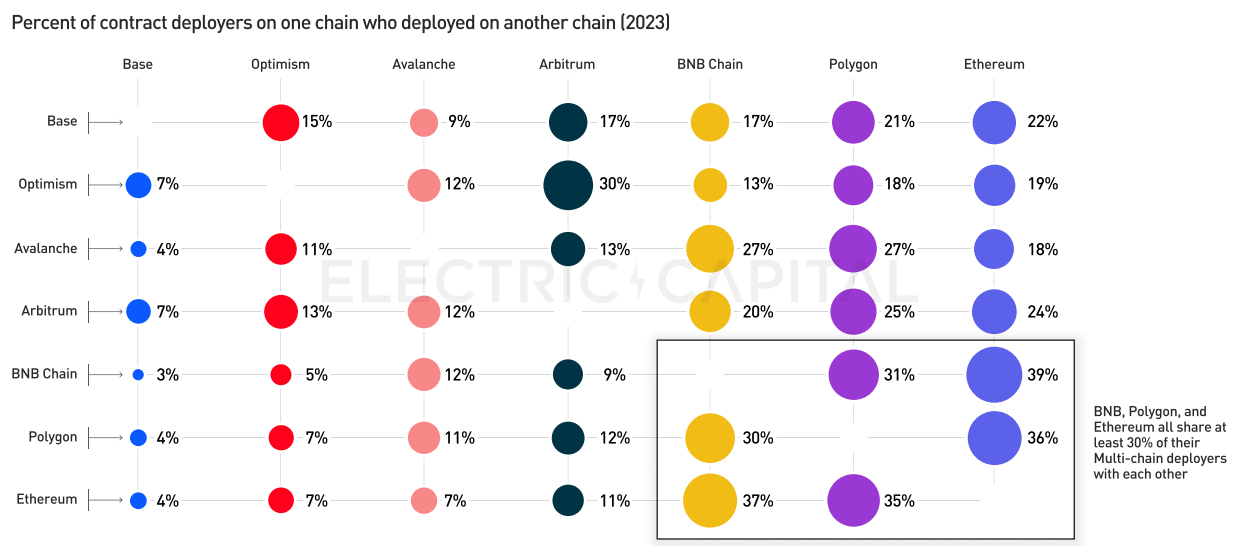
30% of Optimism multi-chain developers participated in the development of Arbitrum, and only 13% of Arbitrum multi-chain developers participated in the development of Optimism.

24% of Arbitrum multi-chain developers are involved in deploying Ethereum, and 11% of Ethereum multi-chain developers are involved in deploying Arbitrum.

Avalanche developers are more likely to be involved in deploying BNB Chain, Polygon, and Ethereum than ETH L2.

Today, 79% of crypto developers work on Bitcoin, Ethereum, or one of the top 200 crypto ecosystems by network value.
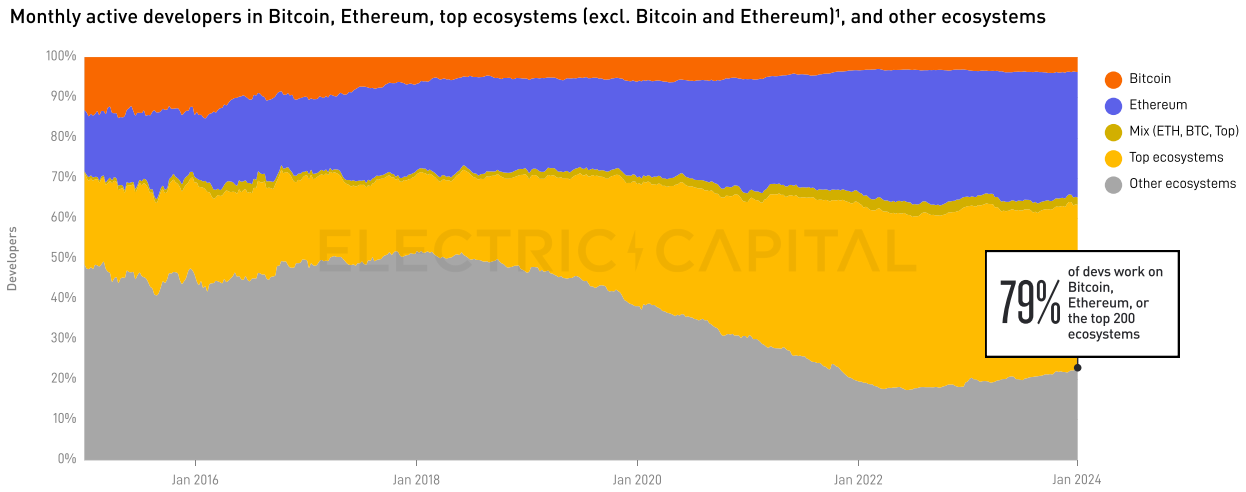
Bitcoin and Ethereum account for 40% of all crypto developers, a number that has remained stable since 2015.

1,071 monthly active developers support Bitcoin, a 19% decline in monthly active developers in 2023.

Mature developers are growing steadily: there are 80% more mature developers than newcomers.
Mature developers saw steady growth of 7%, newcomers fell by 48%, and emerging developers fell by 6%.
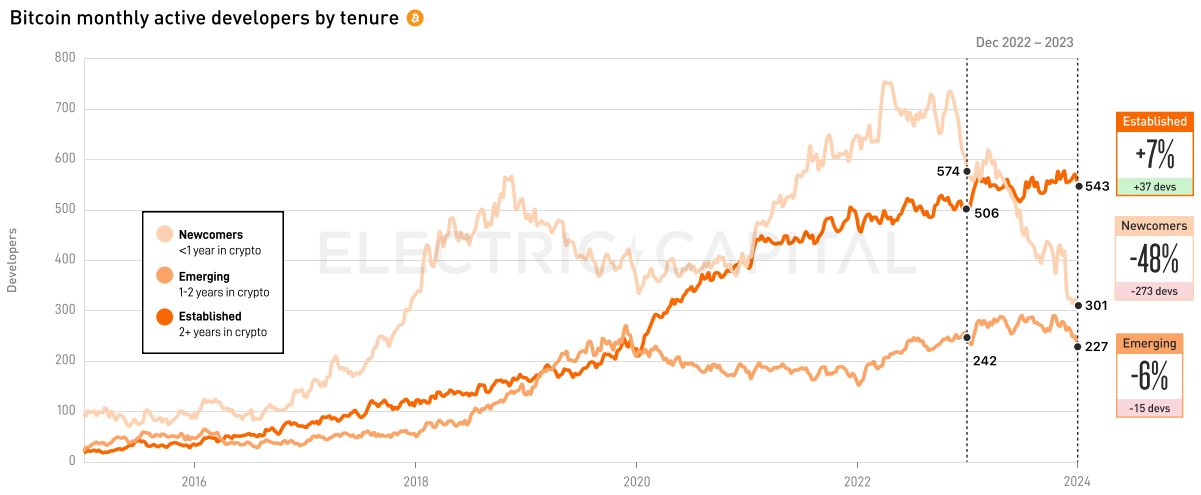
7,864 monthly active developers support Ethereum. Monthly active developers fell 25% in 2023. The majority of developers leaving are newcomers (55%), while established developers grew by 37% and emerging developers were flat.

9,357 monthly active developers work in the top 200 ecosystems outside of Bitcoin and Ethereum, down 31% year-over-year.

Q4 2023 vs Q4 2022 Ecosystems with up to 5,500 developers: Avalanche (-5%), Celo (-11%), Optimism (-16%), Arbitrum (- 16% ), Polkadot (-20% ) and Cosmos (-21% ) lost developers.

NEAR (-33%), BNB (-40%), Polygon (-42%), and Solana (-48%) underperformed their benchmarks due to high growth in 2022.

Scroll (453%), ICP (+37%), zkSync (+32%), Starknet (+30%) and Moonbeam (+5%) gained developer favor.

Aztec (+221%), Celestia (+180%), Aleo (+167%), TON (+37%), Metis (+33%), Status (+31%), Chainlink (+15%) and NOSTR (+2% ) is also gaining traction among developers.

The number of developers has grown significantly since the last bear market: 6,076 new developers per month. Annual growth since 2020 is 30%.

Among them, 3,611 monthly active developers are engaged in DeFi. The number of DeFi developers will drop by 22% in 2023. 57% of developers who left were part-time developers. Since September 2020, more than 300 new developers have joined DeFi every month.

Developers are gradually spreading all over the world
Currently, 72% of crypto developers live outside of North America, 74% of crypto developers live outside of the United States, 12% of crypto developers live in India, and the UK, Germany, and France each account for over 5%.

Although the developer ecosystem grew 2x compared to 2018, the US lost 14% of its developer share (40% in 2018 and 26% in 2023).
The distribution of developers has changed significantly since 2018. The share of the United States, Germany, Australia, the United Kingdom and Canada fell, while that of India, Nigeria, France and Argentina increased.

Developers have been leaving North America and Europe since 2018. Many emerging markets increased their share, while North America, Northern Europe and Western Europe saw their share decrease. Since 2018, North America, Northern and Western Europe, Australia and the Pacific, and East Asia have collectively seen a 23% decline in share; South Asia, Latin America, Eastern Europe, West Africa, and Southern Europe have collectively seen a 20% increase in share.




